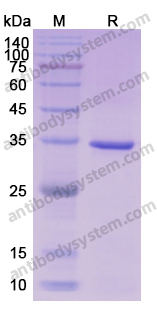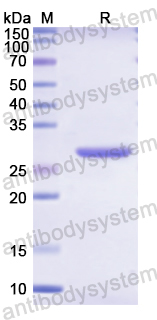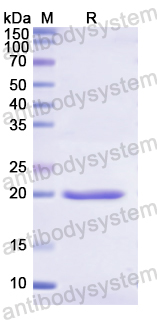Catalog No.
YHC20201
Expression system
E. coli
Species
Homo sapiens (Human)
Protein length
Met1-Met297
Predicted molecular weight
36.41 kDa
Nature
Recombinant
Endotoxin level
Please contact with the lab for this information.
Purity
>90% as determined by SDS-PAGE.
Accession
P06493
Applications
ELISA, Immunogen, SDS-PAGE, WB, Bioactivity testing in progress
Form
Lyophilized
Storage buffer
Lyophilized from a solution in PBS pH 7.4, 0.02% NLS, 1mM EDTA, 4% Trehalose, 1% Mannitol.
Reconstitution
Reconstitute in sterile water for a stock solution.
Shipping
In general, proteins are provided as lyophilized powder/frozen liquid. They are shipped out with dry ice/blue ice unless customers require otherwise.
Stability and Storage
Use a manual defrost freezer and avoid repeated freeze thaw cycles. Store at 2 to 8°C for frequent use. Store at -20 to -80°C for twelve months from the date of receipt.
Alternative Names
CDC28A, CDKN1, P34CDC2, p34 protein kinase, CDK1, Cell division protein kinase 1, Cell division control protein 2 homolog, CDC2, Cyclin-dependent kinase 1
Blocking mutant IDH1 phosphorylation triggers APC/C CDH1-dependent ubiquitination in mitotic cells., PMID:40513618
Identification of key genes in the liver of offspring from obesity maternal mice by bioinformatics analysis., PMID:40513071
Crystal Structure-Activity Relationship of Some MeO Phenylacrylonitriles: Dual Antimicrobial-Cytotoxic Effects and in Silico Perspectives., PMID:40509614
Fenbendazole Exhibits Antitumor Activity Against Cervical Cancer Through Dual Targeting of Cancer Cells and Cancer Stem Cells: Evidence from In Vitro and In Vivo Models., PMID:40509264
Identification of amh and its potential signaling pathway involved in the ovary development in the Largemouth Bass (Micropterus salmoides)., PMID:40499662
Unveiling the Therapeutic Potential of Targeting RRM2 in Hepatocellular Carcinoma: An Integrated In Silico and In Vitro Study., PMID:40493217
Exploring the anti-gastric cancer mechanisms of Diosgenin through integrated network analysis, bioinformatics, single-cell sequencing, and cell experiments., PMID:40487391
Squid-derived protamine: A natural basic protein and its PEGylated derivative as anti-cancer agents in hepatocellular carcinoma., PMID:40484089
MRG15 alternative splicing regulates CDK1 transcriptional activity in mouse cell senescence and myocardial regeneration., PMID:40483328
Clearance of protein aggregates during cell division., PMID:40476343
SENP5 drives breast cancer progression through deSUMOYlation of CDK1., PMID:40474290
A natural flavagline derivative A2073 inhibits the proliferation of erythroleukemia cells by targeting the MAPK, PI3K, NF-κB, and cell cycle pathways., PMID:40460610
Gene expression network analysis identified CDK1 and KIF11 as possible key molecules in the development of colorectal cancer from normal tissues., PMID:40457491
Regulation of Autophagy by the Cdk1/p53/p21 Feedback Loop in an Interstitial Cystitis/Bladder Pain Syndrome Cell Model: Implications for Inflammatory Response., PMID:40447865
Dengue virus modulates critical cell cycle regulatory proteins in human megakaryocyte cells., PMID:40447783
Unveiling an Arpp-19 phosphorylation switch that grants chromosome stability., PMID:40447768
Computer-aided drug discovery of a dual-target inhibitor for ovarian cancer: therapeutic intervention targeting CDK1/TTK signaling pathway and structural insights in the NCI-60., PMID:40446543
Integrative Network Pharmacology Prediction of the Mechanisms of Tri-Ka-Tuk: A Traditional Thai Herbal Formula., PMID:40444620
The Cordyceps Genus as a Potential Source of Bioactive Compounds for Adjuvant Cancer Therapy: A Network Pharmacology Approach., PMID:40430485
NAmiRNA-31 regulates cell cycle by activating ZWINT and promotes lung adenocarcinoma tumor development., PMID:40421481
MicroRNA-34a-5p induces cell cycle arrest and leads to spermatogenesis failure by targeting CDC25A., PMID:40418379
Dynamic SAS-6 phosphorylation aids centrosome duplication and elimination in C. elegans oogenesis., PMID:40410380
APOE mediates the coupling of myogenesis and lipid metabolism in skeletal muscle: decoding intercellular crosstalk via a cell co-culture model., PMID:40409627
Bioinformatics and system biology approach to discover the common pathogenetic processes between COVID-19 and chronic hepatitis B., PMID:40408617
The Schizosaccharomyces pombe nucleolar protein Nsk1 modulates rDNA silencing during interphase., PMID:40406582
Single-cell sequencing and transcriptomic data reveal that P65 activation significantly promotes microglia-mediated neuroinflammation after ischemic stroke., PMID:40404711
Repurposing HIV protease inhibitors as senotherapeutic agents in cervical cancer: Dual targeting of CDK1/6-cell cycle arrest and p53/p21/p16 signaling axis., PMID:40403681
Computational analysis of DEHP's oncogenic role in colorectal cancer., PMID:40397302
Deficiency of Aging-Related Gene Chitinase-Like 4 Impairs Olfactory Epithelium Homeostasis., PMID:40389328
Paris saponin VII restrains PD-L1 mediated immune evasion through the AKT1 and STAT3 signaling pathways., PMID:40389195
Piperlongumine Inhibits Malignant Progression of Esophageal Squamous Cells Through the PI3K/AKT Signaling Pathway., PMID:40383869
Identification of Potential Hub Proteins as Theragnostic Targets in Hepatocellular Carcinoma through Comprehensive Quantitative Tissue Proteomics Analysis., PMID:40375878
In Silico Network Toxicology, Molecular Docking, and Multi-Level Bioinformatics Reveal Methyl Eugenol-Induced Hepatocellular Carcinoma Mechanisms in Humans., PMID:40370109
WDR62 affects the progression of ovarian cancer by regulating the cell cycle., PMID:40369663
Overexpression of FOXM1 drives mycosis fungoides progression by regulating the cell cycle., PMID:40368678
CDC6 Inhibits CDK1 Activity in MII-Arrested Oocyte Cell-Free Extract., PMID:40362544
NANS suppresses NF-κB signaling to promote ferroptosis by perturbing iron homeostasis., PMID:40349344
Ruthenium(II) arene complexes bearing 1,10-phenanthroline substituted with an imidazolium salt: Synthesis, and cytotoxic activities., PMID:40339267
Suppression of Cellular Proliferation in PC3 Prostate Cancer Cells by Green Tea Extract Through Induction of miR-34a Expression., PMID:40336533
Identification of CDK1 as a Biomarker for the Treatment of Liver Fibrosis and Hepatocellular Carcinoma Through Bioinformatics Analysis., PMID:40332418
Deep learning-driven imaging of cell division and cell growth across an entire eukaryotic life cycle., PMID:40327364
A bioinformatics exploration of lung adenocarcinoma identifies hub genes with prognostic significance: from data to discovery., PMID:40320470
Therapy-induced senescence of glioblastoma cells is determined by the p21CIP1-CDK1/2 axis and does not require activation of DREAM., PMID:40319068
Identification and validation of susceptibility modules and hub genes of adrenocortical carcinoma through WGCNA and machine learning., PMID:40317315
Cell cycle duration determines oncogenic transformation capacity., PMID:40307557
Membrane-anchored tissue inhibitor of matrix metalloproteinase (TIMP)-1 promotes cell death in head and neck cancer by inducing DNA damage, accumulating collagen II and disrupting cell survival mechanisms., PMID:40306502
SNRPB2: a prognostic biomarker and oncogenic driver in esophageal cancer via β-catenin/c-Myc signaling., PMID:40303992
IGF2BP3 recruits NUDT21 to regulate SPTBN1 alternative polyadenylation and drive ovarian cancer progression., PMID:40301554
Identification and validation of programmed cell death related biomarkers for the treatment and prevention COVID-19., PMID:40300201
Naphthalimide derivative attenuates tumor growth of wild-type p53-expressing U87 glioma cells in vitro and in vivo through a biphasic dose-dependent mechanism: A switch from cell cycle to apoptosis., PMID:40294493




